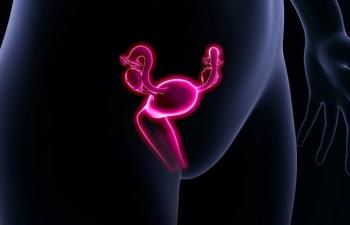
- ONCOLOGY Vol 18 No 4
- Volume 18
- Issue 4
Neoadjuvant Endocrine Therapy for Breast Cancer: An Overlooked Option?
Locally advanced breast canceraccounts for up to 70% ofbreast cancer cases worldwide.[1] In the past decade, neoadjuvantsystemic therapy has emerged asa therapeutic option for early breastcancer. The main goal of neoadjuvanttreatment is to downstage breast tumors,rendering them operable or permittingbreast-conserving surgery.The therapy has been used increasinglyin patients who have large breasttumors and are candidates for mastectomy,but in whom tumor shrinkageallows for less extensive surgeryand better cosmetic results.[2] Thedegree of the tumor’s responsivenessto preoperative therapy could serveas a surrogate for the response ofmicrometastasis to therapy and theconsequent outcome.[3]
Locally advanced breast canceraccounts for up to 70% ofbreast cancer cases worldwide.[1] In the past decade, neoadjuvantsystemic therapy has emerged asa therapeutic option for early breastcancer. The main goal of neoadjuvanttreatment is to downstage breast tumors,rendering them operable or permittingbreast-conserving surgery.The therapy has been used increasinglyin patients who have large breasttumors and are candidates for mastectomy,but in whom tumor shrinkageallows for less extensive surgeryand better cosmetic results.[2] Thedegree of the tumor's responsivenessto preoperative therapy could serveas a surrogate for the response ofmicrometastasis to therapy and theconsequent outcome.[3]Most neoadjuvant studies haveevaluated chemotherapy, with responserates ranging from 60% to90%. The National Surgical AdjuvantBreast and Bowel Project B-18 trialdemonstrated that preoperative chemotherapywith doxorubicin and cyclophosphamide(Cytoxan, Neosar)was as effective as postoperative chemotherapyand permitted morelumpectomies.[3] Similarly, the Oxfordoverview analysis showed thatpatients with estrogen-receptor (ER)-positive tumors achieved a survivalbenefit from adjuvant endocrine therapy,justifying the use of neoadjuvantendocrine therapy in ER-positive tumors.The role of neoadjuvant endocrinetherapy in elderly patients andpatients with severe comorbid conditionsis well established.[4]Aromatase inhibitors in the neoadjuvantsetting provide an excellent alternativeto chemotherapy as they arenot associated with many of the sideeffects seen with cytotoxic therapy.What data do we have, however, tohelp us decide which form of therapyis appropriate based on patient characteristics?Neoadjuvant Endocrine Therapy
Few controlled studies of neoadjuvantendocrine therapy have been conducted.Earlier studies of tamoxifenas primary treatment alone compared to surgery followed by tamoxifendemonstrated good initial responses,but long-term recurrence rates werehigh. These findings led to decreasingenthusiasm for this drug as primarytreatment. Several additional studiesconcluded, however, that tamoxifenwas a reasonable alternative for elderlypatients with operable breast cancer.The development of aromatase inhibitorsand their efficacy in postmenopausalwomen with metastatic breastcancer led to numerous studies of thesedrugs in both the neoadjuvant and adjuvantsettings. An important phase III,double-blind randomized, multicenterstudy conducted by Ellis et al compared4 months of letrozole (Femara)with tamoxifen in postmenopausalwomen who had hormone-receptor-positive breast cancer and were ineligiblefor surgery.[5] In the letrozolegroup, 60% of patients responded vs41% in the tamoxifen groups; 48% underwentsuccessful breast-conservingsurgery in the letrozole group vs 36%in the tamoxifen group.Another objective of this study wasto examine the relationship betweenHER2/neu expression and tumor response.The authors concluded thatER-, ErbB-1-, and ErbB-2-positiveprimary breast cancer responded wellto letrozole, but responses to tamoxifenwere few. Patients with low positivelevels of ER expression wereresponsive to letrozole, leading to theconcern that this subset of patientscould be unnecessarily excluded fromthe benefits of endocrine therapy.These observations brought us onestep closer to an understanding of thebiology of breast cancer.Small studies have also evaluatedexemestane (Aromasin) in the neoadjuvantsetting. The Immediate PreoperativeArimidex Compared toTamoxifen (IMPACT) trial cited byWong and Ellis compared the efficacyof anastrozole (Arimidex) andtamoxifen alone and in combinationas neoadjuvant therapy. Preliminarydata presented at the 2003 San AntonioBreast Cancer symposium showedcomparable efficacy for anastrozoleand tamoxifen in postmenopausalwomen with ER-positive operablebreast cancer, although it should benoted that twice as many patients wereeligible for breast-conserving surgeryin the anastrozole group comparedwith the tamoxifen group.No studies have directly comparedneoadjuvant aromatase inhibitor therapyto neoadjuvant chemotherapy inpostmenopausal women. Wong andEllis have made indirect comparisonsthat are difficult at best, given thedifferent patient characteristics withrespect to age, ER status, menopausalstatus, and size of the tumor. Nevertheless,aromatase inhibitors appearto have better toxicity profiles thanchemotherapy, which has both longtermand short-term adverse effects inthe elderly population. The most commonadverse effects seen with aromataseinhibitors include hot flashes,fatigue, and osteoporosis; their adverseeffect on blood lipids is beinginvestigated further.The extent of breast-conservingsurgery among patients who receivean aromatase inhibitor compared withthose who receive anthracycline-basedtherapy is about the same when T2and larger tumors are included. Overallresponse rates in phase II and IIItrials of neoadjuvant chemotherapyrange from 48% to 95%, but most ofthese trials did not report responserates based on ER status.[6]Survival
No randomized studies have comparedsurvival of patients treated withneoadjuvant endocrine therapy followedby surgery with those undergoingsurgery followed by adjuvantendocrine therapy. Current evidencesuggests that no survival advantage isassociated with neoadjuvant systemictherapy, but there is also no obviousdownside to this therapy. In lieu oflong-term randomized or observationalstudies, the only means by which toassess improved survival would bethe development of valid biomarkersas surrogates of long-term outcome.Conclusions
Neoadjuvant endocrine therapy hasa probable role in elderly postmenopausalpatients with significant comorbidities.Well-designed randomizedtrials comparing neoadjuvant aromataseinhibitor therapy with neoadjuvantchemotherapy would assistclinicians in their treatment decisions.Development of validated biomarkersthat could predict response would aidin tailoring medical therapy to individualpatients, as demonstrated in theresponsiveness of ER-positive, HER1-positive, and HER2-positive patientsto letrozole. This strategy should bestudied further. Additional studies ofthe molecular mechanisms of estrogendependentbreast cancer should also beconducted. Microarray gene analysisstudies are ongoing in an attempt todetermine which tumors will respondto neoadjuvant endocrine therapy.
Disclosures:
Dr. Vogel receivesgrant or research support from NIH/NCI/NSABP, Pfizer, and Novartis; is a paid consultantfor Cytyc Health Corp; and is a member ofthe speaker’s bureau for AstraZeneca, Pfizer,Eli Lilly, and Novartis.
References:
1.
Bear HD: Indications for neoadjuvantchemotherapy for breast cancer. Semin Oncol25(2 suppl 3):3-12, 1998.
2.
Bonadonna G, Veronesi U, Brambilla C,et al: Primary chemotherapy to avoid mastectomyin tumors with diameters of three centimetersor more. J Natl Cancer Inst 82:1539-1545, 1990.
3.
Fisher B, Bryant J, Wolmark N, et al: Effectof preoperative chemotherapy on the outcomeof women with operable breast cancer. JClin Oncol 16:2672-2685, 1998.
4.
Hoff PM, Valero V, Buzdar AU, et al: Combinedmodality treatment of locally advancedbreast carcinoma in elderly patients or patientswith severe comorbid conditions usingtamoxifen as the primary therapy. Cancer88:2054-2060, 2000.
5.
Ellis MJ, Coop A, Singh B, et al: Letrozoleis more effective neoadjuvant endocrine therapythan tamoxifen for ErbB-1- and/or ErbB-2-positive,estrogen receptor-positive primary breastcancer: Evidence from a phase III randomizedtrial. J Clin Oncol 19:3808-3816, 2001.
6.
Shannon C, Smith I: Is there still a rolefor neoadjuvant therapy in breast cancer? CritRev Oncol Hematol 45:77-90, 2003.
Newsletter
Stay up to date on recent advances in the multidisciplinary approach to cancer.



















































































